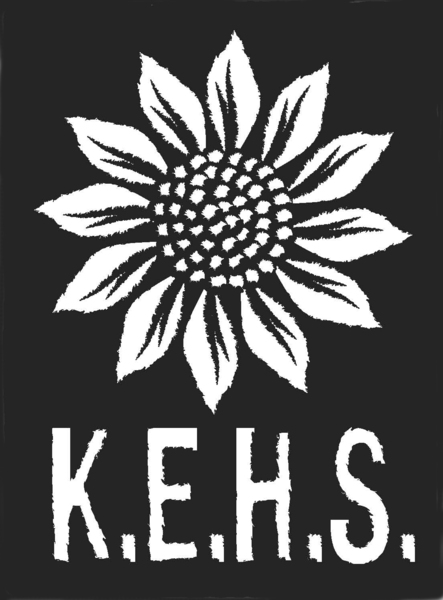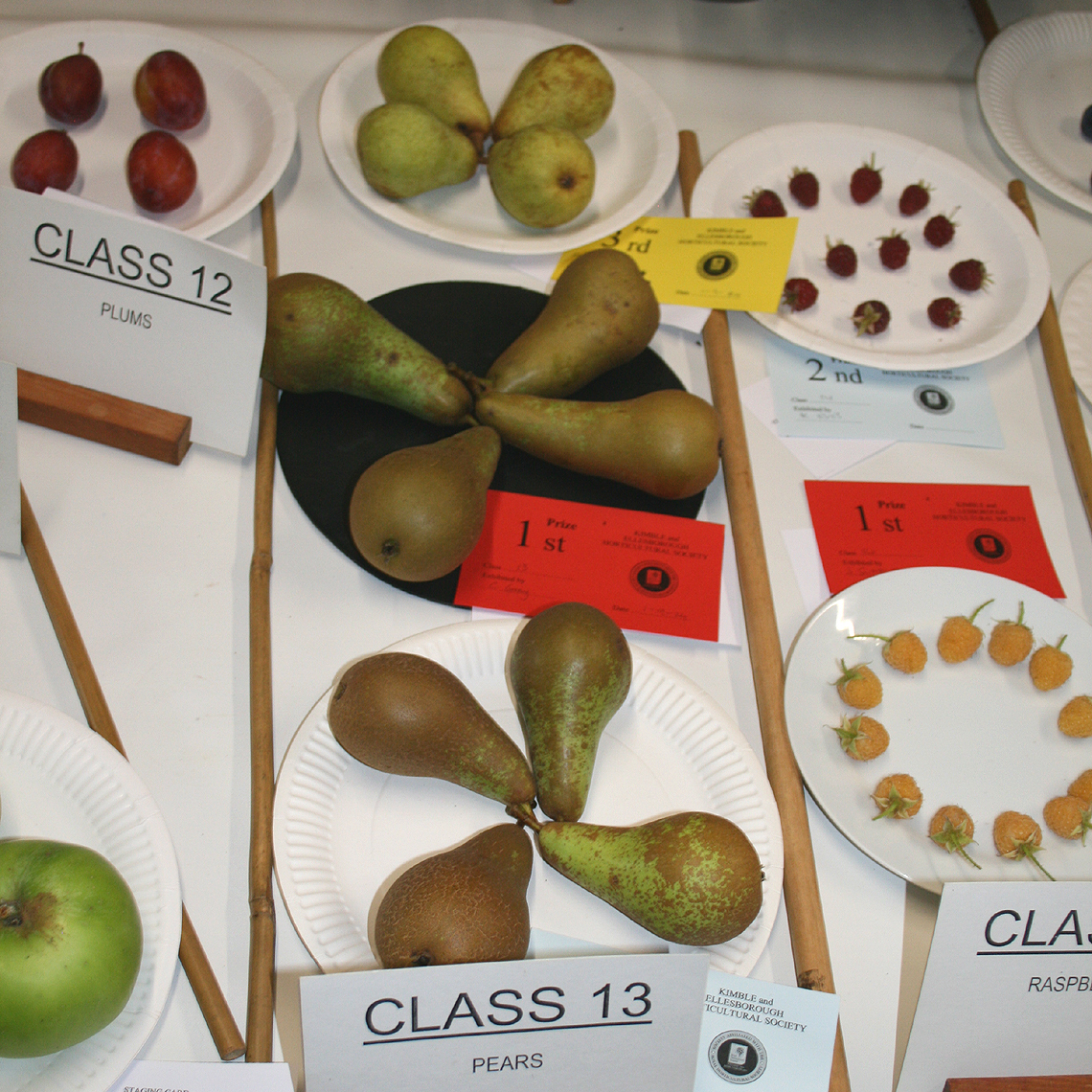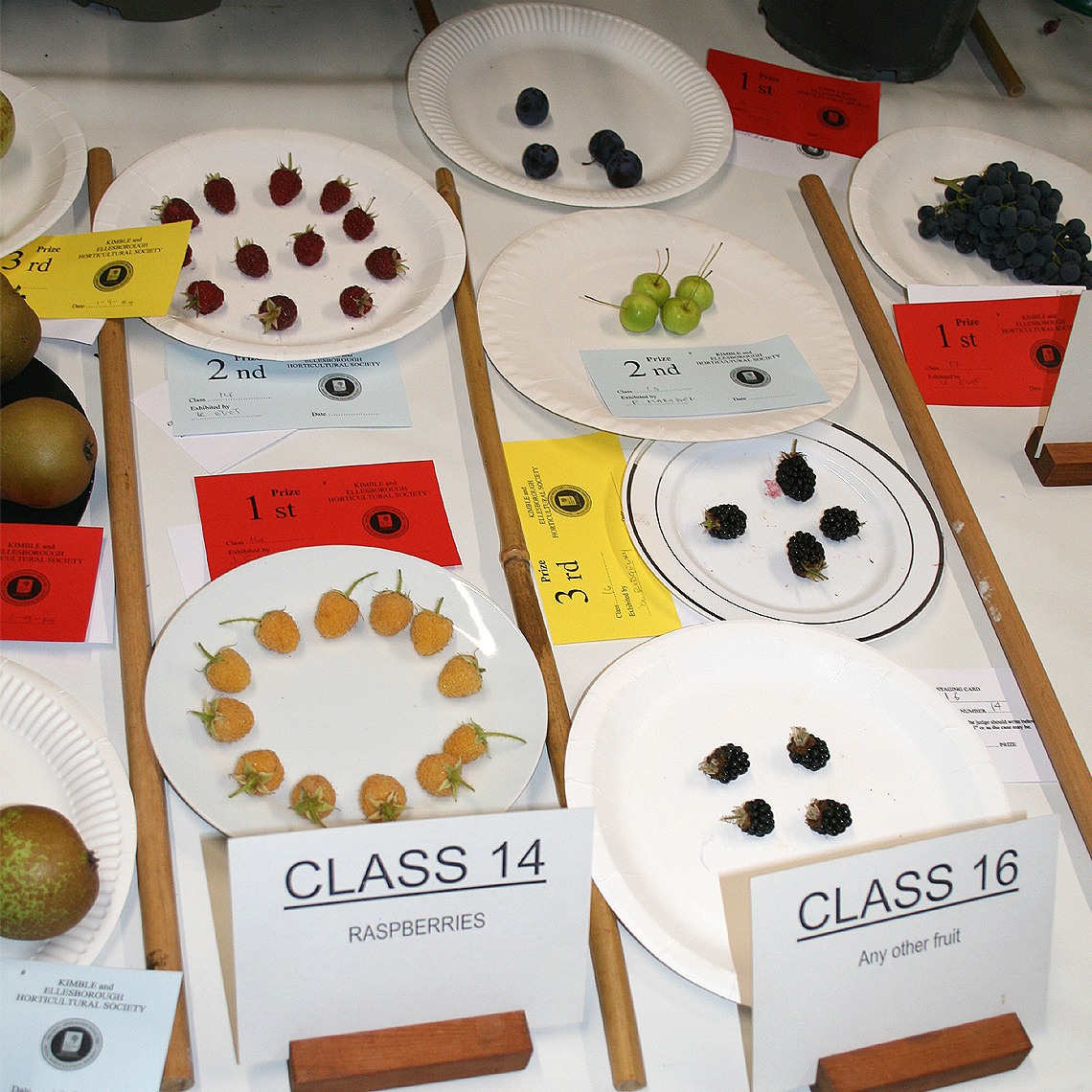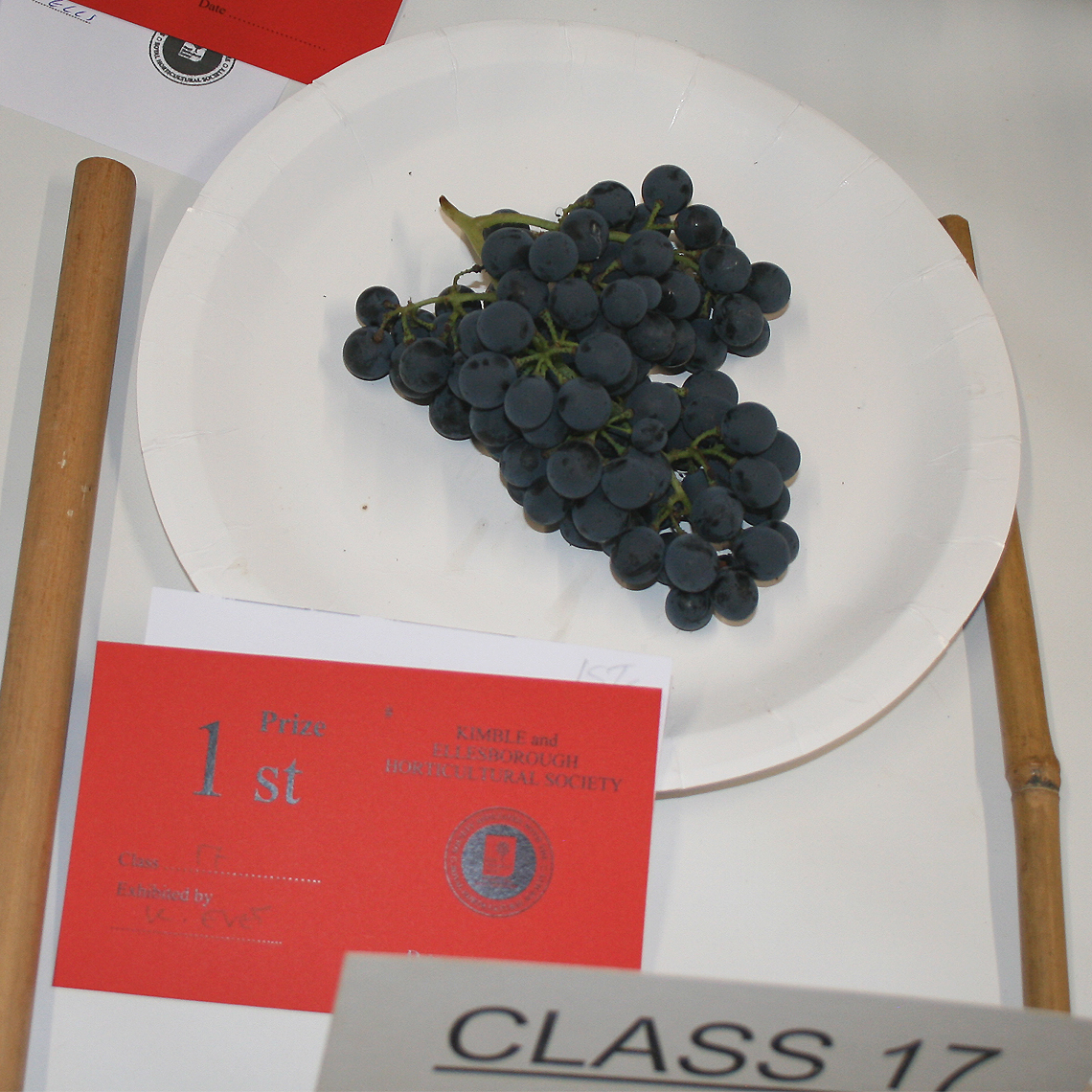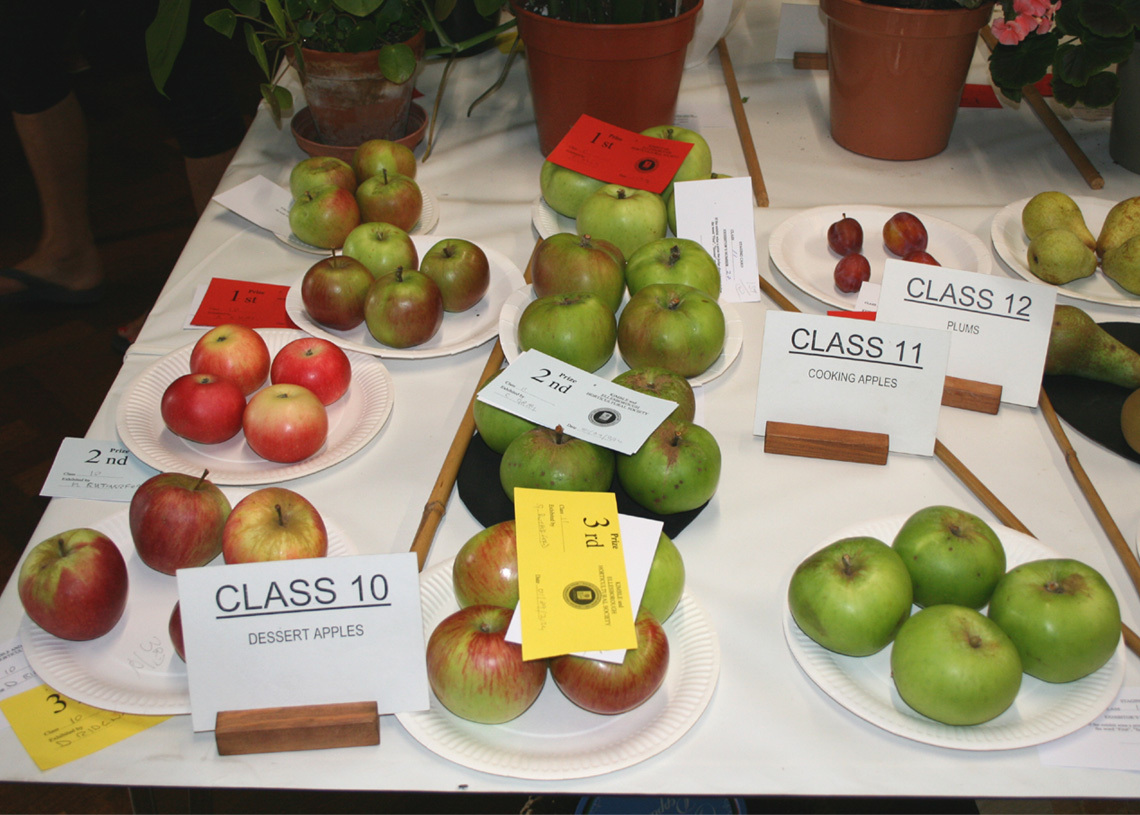This guide offers some information on what judges are looking for and recommendations on presentation which may be useful to new and less experienced exhibitors.
KEHS fruit classes are judged by NVS judges based on the RHS fruit pointing system. The four factors which are scored are condition, uniformity, size and colour.
You will find more information about pointing and the scale of points for the most common fruits at the end of the guide.
FRUIT – GENERAL TIPS FOR EXHIBITORS
Make sure you read the Show Schedule carefully, noting the requirements for each class including the number of specimens stipulated and any requirements re size and their display.
Failure to display the number of specimens required for the class is a common reason for the exhibit being classed as NAS (not according to schedule).
Try and ensure that your specimens for the class are a uniform shape and size. Large specimens may be desirable but this should not be at the expense of uniformity and quality.
They should be in as good a condition as possible, ie unbroken skins and free of blemishes, pest damage and disease.
Fruit should have a fresh colour and the shape should be typical for the cultivar.
They should be carefully cleaned to avoid any damage. Try to preserve the natural bloom. They should not be oiled.
Exhibits will consist of one variety, unless otherwise specified in the schedule.
Try to display them as attractively as possible in accordance with the rules and schedules. For example, raspberries are traditionally arranged in a circle and pears with their stalks pointing inwards.
Where possible, it’s a good idea to take a few extra specimens in case of mishaps.
If you have any queries please contact the Show Secretary before the Show.
GENERAL RULES AND TIPS FOR FRUIT
The following information is based on the Royal Horticultural Society’s guides to exhibiting fruit. It includes a selection of useful information on what to look out for when choosing your exhibits and recommendations for presentation so that the display is neat and pleasing to look at. It can only be a summary and factors such as the need for freshness, being blemish free and with appropriate colour and shape for the cultivar should be taken as a given.
Apples, gooseberries, medlars, pears and quinces may be shown ripe or unripe. Everything else should be ripe unless otherwise specified. Preference will be given to cultivars in season rather than larger showy cultivars picked prematurely.
Re size, all fruits except dessert apples should be of good size for the cultivar but an overly large size should not be preferred at the expense of quality.
Unless specified, fruits should be shown with stalks.
As a general rule, apples and similar-shaped fruits should be shown stalk end facing down.
Apples: Cooking apples should be large and shapely with undamaged eyes, stalks intact and unblemished skins. Desert apples should be as above and characteristic of the cultivar. They should be about 75mm in diameter unless the cultivars are inherently large or small. Presentation – the RHS suggests staging apples on a plate stalk side down but stalks side up is quite acceptable at our show.
Apricots: Fruits should be large and highly coloured, handle carefully to preserve the bloom. They should be shown without stalks. Presentation - in lines or a circular arrangement.
Blackberries: They should be large with fresh calyces and have stalks. Presentation – arrange in a line with stalks pointing the same way or in a circle with stalks pointing out, a combination of the two. They also look good in full sprigs.
Cherries: Sour cherries should be large with a brilliant colour and unshrivelled stalks. Sweet cherries as above. Presentation – lay out in lines with the stalks in the same direction or in a circle with stalks pointing outwards.
Currants: Black currants strigs should have a full complement of uniform and bright looking berries with fresh stalks (a strig is a complete receme or panicle of berries). Currants other than black as above. Presentation – they may be neatly spread across the centre of a plate or formed into a ring with the stalk ends pointing out, especially if the cultivar produces naturally short strigs.
Damsons and Bullaces: These should be carrying perfect bloom and have stalks (otherwise judges may dock points). Presentation – either in a circle or symmetrical lines.
Figs: Slight splitting is not a defect in ripe fruit. They should have bloom and stalks intact. Presentation -stage in a circle on a plate. Round figs look best sat with stalks uppermost and long-bodied figs are best placed flat on the plate with the stalks in the centre.
Gooseberries: They may be ripe or unripe as appropriate for the season and be complete with stalks. Presentation -they look best in a ring with the stalks pointing inwards and the tails (remnants of the flowers) pointing out.
Grapes, Indoor/Glasshouse: Bunches should be large and complete. It is better to have smaller bunches of a good quality than large, poor quality bunches. Bunches should be symmetrical and well-balanced and properly thinned so each berry has had room to develop. There should be a dense, intact bloom. Presentation – they should be shown with a piece of lateral stem on either side of the stalk to form a T-handle. They can be presented on a stand or simply arranged on a plate.
Grapes, Outdoor: Bunches should be complete, well-filled and balanced with a dense, intact bloom. Presentation – fruit should be cut from the vine with about 50mm of stalk.
Hybrid Berries: They should be large with fresh calyces and have stalks. Examples are loganberries, tayberries and boysenberries.
Medlars: Skins should be clean and stalks should be intact with size according to cultivar. They should preferably be shown ripe but can be shown unripe. Presentation - arrange in a circle with the stalks facing inwards.
Melons: Fruits should be clean, shapely and well finished. They should be cut from the vine with approx. 50mm of stalk.
Nectarines: They should be large for the cultivar, with well developed colour. Take care they are free from bruises. They should be shown without stalks.
Peaches: As nectarines.
Pears: Cooking pears should be large with undamaged eyes and intact stalks. Dessert pears as above. Presentation – best stage flat placed neatly with stalks towards the centre but rounder cultivars may be staged like apples.
Plums: Cooking plums should have good bloom and stalks. Dessert plums as above. Presentation – stage on their sides either in a circle with stalks facing inwards or in symmetrical lines with stalks pointing the same way.
Quinces: Fruits should be shapely with eyes and stalks intact. Presentation – pear shaped cultivars are best staged as pears and rounder ones like apples.
Raspberries: Fruits should be large and ripe with fresh calyces and stalks. Presentation should be neat and symmetrical – they look good in near rows with stalks pointing in the same direction or can be arranged in circle around the plate with stalks pointing out.
Strawberries: Fruits should look bright and fresh with good ripening throughout (not “hard-nosed”). They should have fresh calyces and stalks. Presentation – lay in neat lines or a circle with stalks pointing the same way
FRUIT COLLECTIONS
KEHS has a basket collection, similar to the vegetable basket apart from the dimensions.
Basket
The composition can be very varied so careful consideration of both the pointing schedule and the size of the container is important to select the best options.
Class 20 – Basket of Mixed Fruits. Presentation requirements: basket not to exceed 300mm in width or length.
(See Definitions and Pointing for more information).
SCALE OF POINTS FOR FRUIT
The RHS system is based on four factors which are:
- Condition
- Uniformity
- Size
- Colour
The points available depend on the difficulty of growing and presenting the fruit.
The total number of points available therefore varies depending on the class so, for example, you can achieve a maximum of 20 points for grapes, peaches or dessert pears but would only get upto 12 points for blackberries or raspberries.
|
Fruit |
Points |
Fruit |
Points |
|
Apples, cooking |
18 |
Grapes, glasshouse |
20 |
|
Apples, dessert |
20 |
Hybrid Berries |
12 |
|
Apricots |
16 |
Medlars |
8 |
|
Blackberries. |
12 |
Melons |
18 |
|
Bullaces |
8 |
Nectarines |
20 |
|
Cherries, sweet |
16 |
Peaches |
20 |
|
Cherries, sour |
12 |
Pears, cooking |
18 |
|
Currants, black |
12 |
Pears, dessert |
20 |
|
Currants, other than black |
10 |
Plums, cooking |
14 |
|
Damsons |
8 |
Plums, dessert |
16 |
|
Figs |
16 |
Quinces |
12 |
|
Gooseberries |
12 |
Raspberries |
12 |
|
Grapes grown outdoors |
16 |
Strawberries |
16 |
Pointing for Fruit Collections
|
Type of Collection |
Pointing |
| Basket |
Quality - 20 points Variety - 20 points Presentation - 20 points Total - 60 points |
OTHER SOURCES OF INFORMATION
The Horticultural Show Handbook – Royal Horticultural Society
The Great British Village Show – Royal Horticultural Society
Guide to Fruit for Exhibition - Royal Horticultural Society
